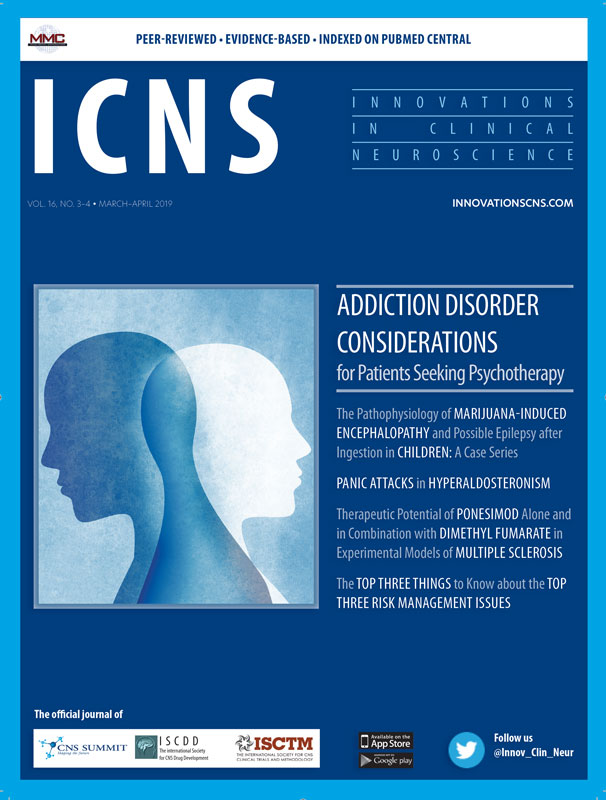
Dear Colleagues:
Welcome to the March–April 2019 issue of Innovations in Clinical Neuroscience (ICNS). We start this issue with a Psychotherapy Rounds submission titled, “Addiction Disorder Considerations in Patients Seeking Psychotherapy,” by Stubbs and Merrill. It is not uncommon for a patient with a psychiatric disorder to present with a comorbid substance use disorder, and vice versa. Using composite case vignettes as examples, the authors reviews strategies to aid the practicing clinician in the screening, assessment, intervention, and treatment referral of their parents at risk for substance use disorders.
Next, in a case series by Carvahlo and Evans-Gilbert titled, “The Pathophysiology of Marijuana-induced Encephalopathy and Possible Epilepsy after Ingestion in Children: A Case Series,” the authors review the pathophysiology of marijuana encephalopathy and its potential to cause seizures following its ingestion in infants and young children. The authors present six cases as examples and discuss differential diagnoses and treatment.
Next, in a case report titled, “Panic Attacks in Hyperaldosteronism,” by Lin, Hedrick, and IsHak, the authors describe a patient with new-onset hyperaldosteronism secondary to adrenal adenoma who presented with recurrent panic attacks. Discussion regarding the mechanistic relationship between primary hyperaldosteronism and panic attacks is provided, as well as differentials and treatment (the patient underwent adenoma resection).
Following this, Pouzol et al present their study titled, “Therapeutic Potential of Ponesimod Alone and in Combination with Dimethyl Fumarate (DMF) in Experimental Models of Multiple Sclerosis.” Here, the investigators evaluated the therapeutic effect of ponesimod monotherapy as well as the potential synergistic activity of combining ponesimod and DMF in experimental autoimmune encephalomyelitis (EAE) animal models of MS. The authors report that the ponesimod monotherapy in the mouse EAE model showed significant efficacy, as both a preventative and therapeutic treatment, and in the rat EAE model, ponesimod demonstrated significant dose-dependent efficacy on clinical scores; DMF showed only modest activity. Additionally, the authors report that the combination therapy demonstrated a reduction in the severity and prevalence of disease, suggesting synergistic activity between the two agents. Based on the results, the authors postulate that, in addition to DMF, combining ponesimod with other oral agents with different mechanisms of action might be therapeutically beneficial to patients with MS and should be investigated.
We close the issue with a Risk Management submission by Cash titled, “The Top Three Things to Know about the Top Three Risk Management Issues.” Here the author reviews the three most common areas of interest among psychiatrists seeking consultation on risk management: 1) requests for information, 2) documentation, and 3) termination of treatment. For each topic, the author provides three key pearls of advice. The author reminds the reader that while consultation on these three topics is the most commonly requested, these topics do not represent the greatest professional liability risk exposures for psychiatrists, which are considered medication adverse events and patient suicide or attempted suicide. The author encourages readers to review available resources on these risks from their professional societies and licensing boards.
We hope you enjoy this issue of ICNS. As always, we welcome your submissions and feedback.
Sincerely
Amir Kalali, MD
Editor, Innovations in Clinical Neuroscience





